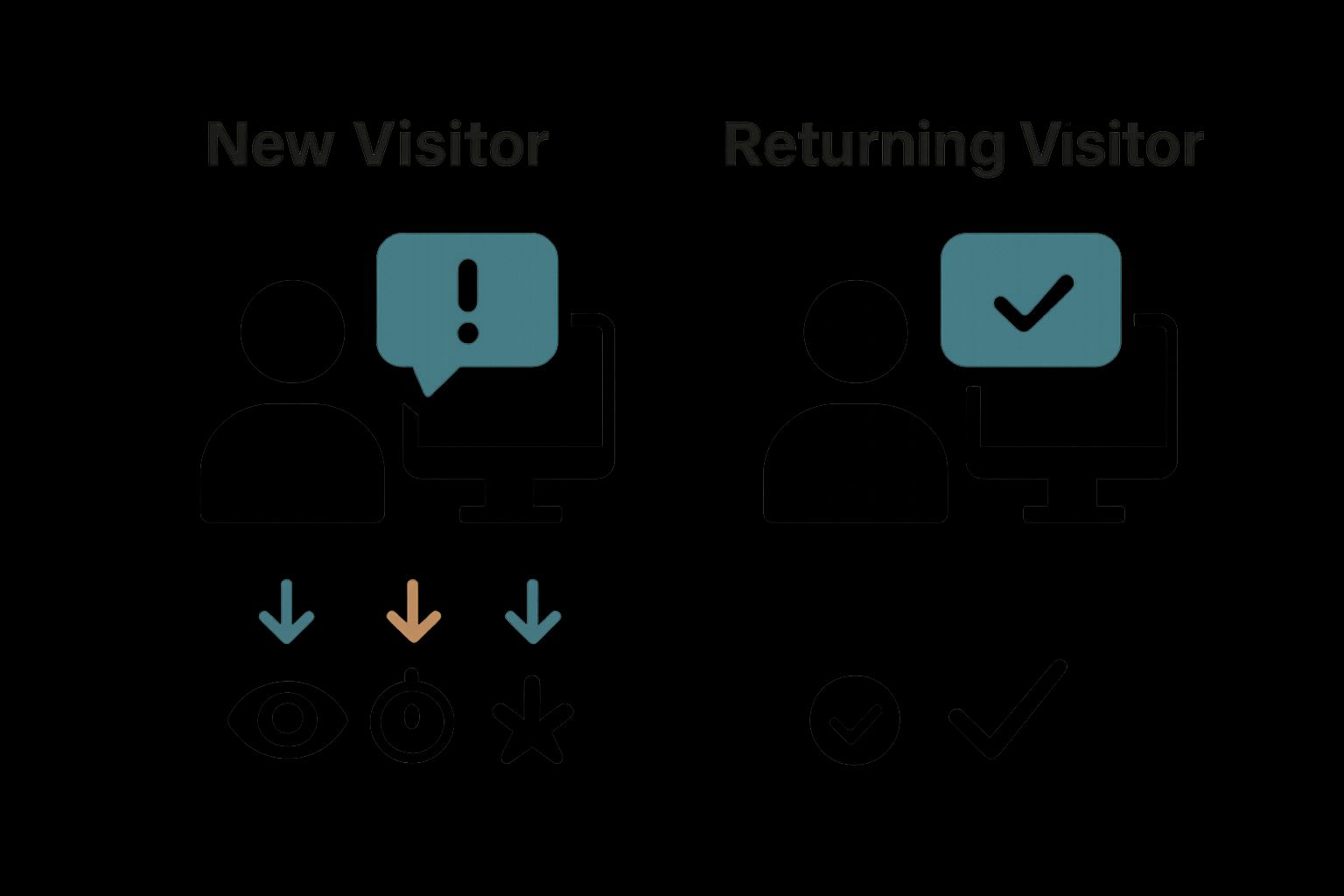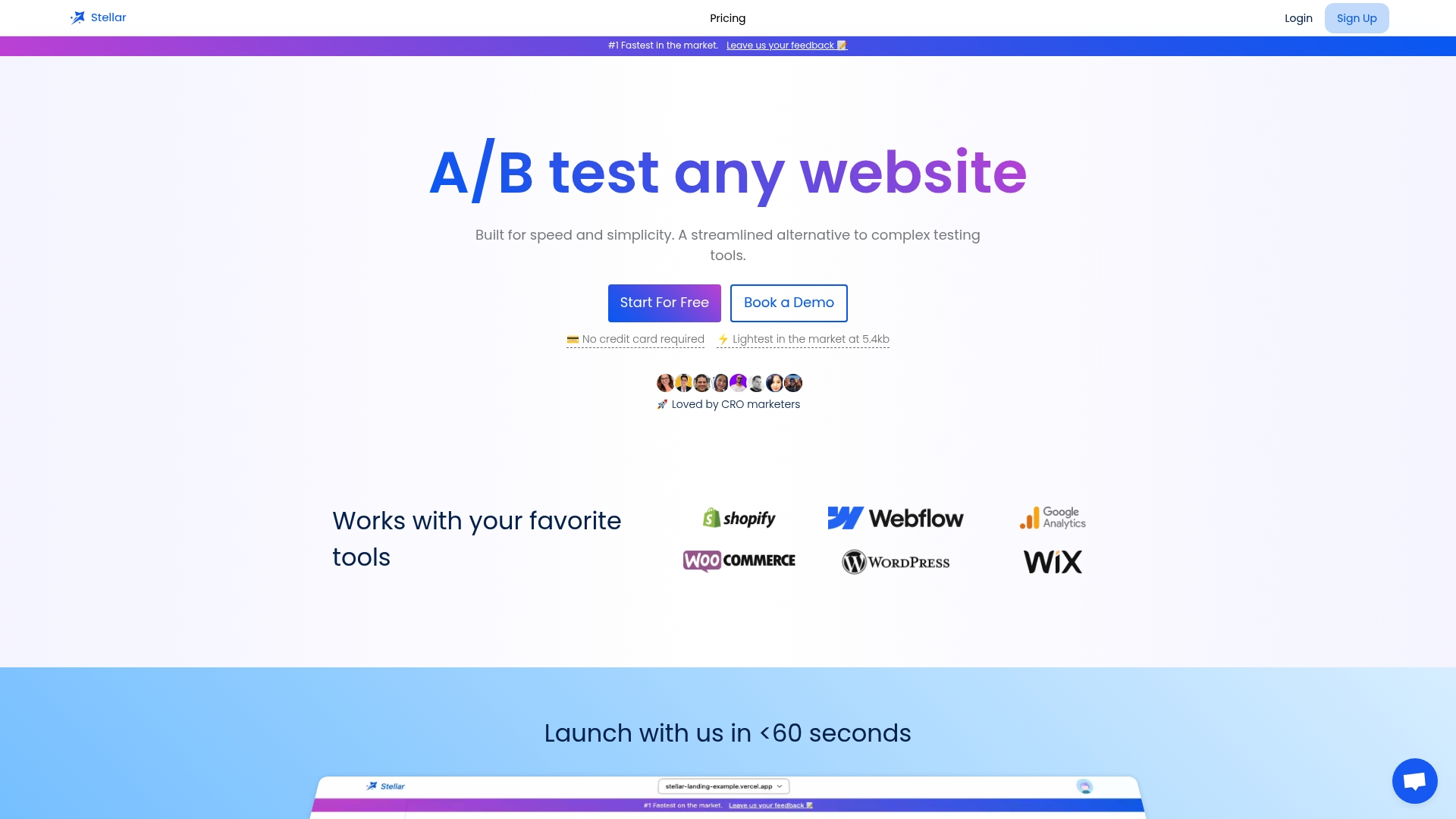
Understanding Testing New vs Returning Visitors

Every website has a mix of curious newcomers and loyal repeat visitors. Personalized marketing can deliver five to eight times the return on investment compared to generic campaigns. Surprised? Many businesses still track all their website traffic the same way, missing out on deep insights. The real power lies in knowing how these two groups behave differently and using that data to drive smarter decisions.
Table of Contents
- Defining New and Returning Visitors: Key Concepts
- The Importance of Segmenting Visitor Types for Marketing
- Analyzing Visitor Behavior: How New and Returning Users Differ
- Strategies for Effective Testing of Visitor Segments
- Real-World Impacts of Testing New vs Returning Visitors
Quick Summary
| Takeaway | Explanation |
|---|---|
| Segment visitors for targeted marketing | Distinguishing between new and returning visitors enhances targeted marketing strategies and engagement approaches. |
| Understand behavioral differences | New visitors seek information, while returning visitors require deeper, more specific interactions for effective engagement. |
| Utilize personalized content strategies | Tailoring content and user experiences increases the effectiveness of marketing initiatives and conversion rates. |
| A/B testing boosts effectiveness | Implementing robust testing for visitor segments helps identify unique patterns and improve marketing outcomes significantly. |
| Measure and refine strategies continuously | Ongoing measurement and adjustment of marketing strategies ensure that they remain effective and responsive to user behavior changes. |
Defining New and Returning Visitors: Key Concepts
In digital marketing and web analytics, understanding visitor types is crucial for effective performance tracking and strategic optimization. New visitors and returning visitors represent two fundamental audience segments that provide critical insights into user behavior, engagement patterns, and website performance.
What Distinguishes New from Returning Visitors
Visitor classification fundamentally depends on tracking mechanisms like browser cookies. According to Google Analytics support, a new visitor is typically defined as someone accessing your website for the first time from a specific device and browser. Conversely, a returning visitor is identified when the same browser revisits the website within a specified tracking timeframe.
Key characteristics of visitor types include:

- New Visitors
- First-time website interaction
- No previous browsing history on the site
- Potentially discovered through marketing channels
- Higher likelihood of exploratory behavior
- Returning Visitors
- Previously engaged with the website
- Recognized by stored browser cookies
- Potentially more familiar with site navigation
- Higher potential for conversion
Technical Nuances of Visitor Tracking
Visitor identification is not always straightforward. Technical limitations like cookie deletion, device switching, or using private browsing modes can complicate accurate tracking. For instance, a user might appear as a new visitor if they clear their browser cookies or access the site from a different device, even if they have previously visited.
Understanding these technical nuances helps marketers and analysts interpret web traffic data more accurately. By recognizing the limitations of visitor tracking, businesses can develop more sophisticated strategies for user engagement and conversion optimization.
The Importance of Segmenting Visitor Types for Marketing
Segmenting website visitors is a powerful strategy that transforms raw traffic data into actionable marketing insights. By distinguishing between new and returning visitors, businesses can craft more personalized, targeted experiences that significantly enhance user engagement and conversion potential.
Strategic Marketing Implications
Visitor segmentation allows marketers to develop nuanced approaches tailored to different audience behaviors. According to research from Harvard Business Review, personalized marketing strategies can deliver five to eight times the return on investment compared to generic campaign approaches.
Key strategic benefits of visitor segmentation include:
- Performance Optimization
- Create targeted user experiences
- Develop precise marketing messaging
- Allocate resources more effectively
- Improve overall conversion rates
Behavioral Insights and Personalization
Returning visitors and new visitors exhibit distinctly different behavioral patterns. While new visitors typically require more introductory information and broader engagement strategies, returning visitors often seek deeper, more specific interactions. Understanding these differences enables marketers to design contextually relevant content that speaks directly to each segment's unique needs and expectations.
For instance, a returning visitor might appreciate more advanced product details or exclusive offers, whereas a new visitor would benefit from comprehensive explanatory content about the product or service. You can learn more about effective test data strategies to further refine these segmentation approaches.
By meticulously analyzing visitor types, businesses can transform generic web traffic into strategic opportunities for personalized marketing, ultimately driving more meaningful user interactions and improved conversion outcomes.
Analyzing Visitor Behavior: How New and Returning Users Differ
Understanding the distinct behavioral patterns of new and returning visitors provides marketers with critical insights into user engagement strategies. While both visitor types contribute to website traffic, their interactions, motivations, and conversion potential vary significantly.
To provide a clear contrast between the behaviors and motivations of new and returning website visitors, the following comparison table summarizes their key characteristics.
| Visitor Type | Typical Behavior | Motivation | Conversion Potential | Familiarity With Site |
|---|---|---|---|---|
| New Visitors | Exploratory browsing, high information seeking | Initial assessment, seeking information | Lower initial probability | Low |
| Returning Visitors | Targeted interactions, faster navigation | Focused objectives, specific interests | Higher, ready for conversion | High |
Engagement Patterns and User Intent
Research from Forrester reveals that returning visitors demonstrate substantially different browsing behaviors compared to new visitors. New visitors typically approach websites with exploratory intentions, seeking initial information and assessing overall value. Returning visitors, conversely, arrive with more focused objectives, often having a clearer understanding of the product or service.
Key behavioral differences include:
- New Visitor Characteristics
- Higher information consumption rates
- More time spent navigating website structure
- Greater likelihood of comparative research
- Lower initial conversion probability
- Returning Visitor Characteristics
- Faster navigation through website
- More targeted interaction with specific content
- Higher potential for immediate conversion
- Enhanced familiarity with brand offerings
Conversion Dynamics and User Experience
The conversion journey dramatically differs between new and returning visitors. New visitors require comprehensive information, clear value propositions, and trust-building elements. Trust signals, such as testimonials, detailed product explanations, and transparent pricing, become crucial in transforming their initial curiosity into genuine interest.
Returning visitors, having already established a baseline understanding, seek more nuanced interactions. They are more receptive to advanced content, specialized offers, and deeper engagement opportunities. Learn more about segmentation strategies to optimize these distinct user experiences.
By recognizing and adapting to these behavioral nuances, marketers can design more intelligent, responsive web experiences that effectively cater to each visitor type's unique needs and expectations.
Strategies for Effective Testing of Visitor Segments
Testing visitor segments requires a sophisticated, data-driven approach that goes beyond surface-level analysis. By implementing targeted testing methodologies, marketers can uncover nuanced insights about user behavior, preferences, and conversion potential across different visitor types.
Segmentation and Experimental Design
According to the Usability.gov A/B Testing Guidelines, effective segmentation testing demands careful control of variables and precise measurement techniques. The goal is to create experiments that provide statistically significant insights into how new and returning visitors interact differently with website elements.
Key considerations for robust segment testing include:
- Experimental Parameters
- Isolate specific visitor type variables
- Establish clear control and test groups
- Define precise measurement metrics
- Ensure statistical significance
Advanced Testing Methodologies
Successful visitor segment testing requires a multi-dimensional approach. Behavioral targeting becomes crucial in developing nuanced testing strategies that recognize the unique characteristics of different visitor groups. Check out our guide on choosing effective test variants to refine your experimental approach.
Marketers should focus on:
- Strategic Testing Approaches
- Create segment-specific user experience variations
- Develop distinct conversion path experiments
- Analyze micro-interaction differences
- Implement personalized content strategies
By meticulously designing tests that account for the unique behaviors of new and returning visitors, businesses can develop more sophisticated, targeted marketing strategies that dramatically improve user engagement and conversion rates.
Real-World Impacts of Testing New vs Returning Visitors
The practical application of visitor segmentation testing extends far beyond theoretical concepts, delivering tangible business outcomes that can significantly transform digital marketing strategies and user experience design.
Performance Metrics and Business Outcomes
Research from PLOS One journals demonstrates that targeted website experiences based on visitor type can dramatically improve conversion rates and user engagement. Organizations that implement sophisticated segmentation strategies often observe substantial improvements in key performance indicators across both new and returning visitor categories.
This table summarizes the advantages businesses can gain from testing and segmenting new versus returning visitors as described in the article.
| Benefit | Impact on Business | Related Visitor Segment |
|---|---|---|
| Enhanced Conversion Rate Optimization | Drives more conversions through targeting | Both (New and Returning Visitors) |
| More Efficient Resource Allocation | Allocates marketing spend strategically | Both |
| Improved User Retention Metrics | Keeps users engaged and returning | Returning Visitors |
| Increased Overall Website Performance | Boosts KPIs across engagement and sales | Both |
| Personalized User Experiences | Customizes content for greater relevance | Both |
Key real-world impacts include:
- Quantifiable Business Benefits
- Enhanced conversion rate optimization
- More efficient marketing resource allocation
- Improved user retention metrics
- Increased overall website performance
Strategic Implementation Insights
Personalization becomes the cornerstone of effective digital experiences when businesses recognize the distinct behavioral patterns of new and returning visitors. By tailoring content, design elements, and user journeys to specific visitor segments, companies can create more resonant, compelling web interactions.
Complex digital environments require nuanced approaches. Check out our recommendations on test duration best practices to ensure your segmentation testing remains statistically robust and actionable.
Critical strategic considerations for real-world implementation involve continuous measurement, iterative refinement, and a commitment to understanding the evolving digital behavior of different visitor types. By embracing this dynamic approach, businesses can transform raw website traffic into meaningful, conversion-driving user experiences.

Supercharge Visitor Testing With Stellar’s Real-Time A/B Platform
Are you struggling to accurately test new vs returning visitors and frustrated by slow, complex tools that disrupt your website’s user experience? When you need reliable data to segment users, drive conversions, and act on insights fast, technical barriers and performance issues should never stand in your way. Your goal is clear: create targeted experiences and increase conversions by understanding the behavioral differences discussed in this article.

Now is the perfect time to transform your testing process with Stellar, the fastest SaaS A/B testing platform built for marketers who want simplicity without compromise.
- Launch sophisticated tests for new and returning visitors using a lightweight 5.4KB script
- Use the Visual Editor for instant no-code setup and on-the-fly adjustments
- Unlock advanced goal tracking with real-time analytics
Take control of your segmentation and start converting insights into action. Speed up your results with Stellar today and see the difference powerful simplicity makes.
Frequently Asked Questions
What are the key differences between new and returning visitors?
New visitors are individuals accessing your website for the first time, typically showing exploratory behavior, while returning visitors have prior experience with your site, indicating a higher likelihood of conversion due to their familiarity with its content and navigation.
How can I effectively track new and returning visitors?
Tracking new and returning visitors typically relies on browser cookies. If a user visits your site for the first time, they are categorized as a new visitor. If they return within a specified timeframe without clearing cookies, they are classified as a returning visitor.
Why is it important to segment new and returning visitors in digital marketing?
Segmenting new and returning visitors allows businesses to tailor their marketing strategies effectively. New visitors may require introductory content, while returning visitors often seek more specific, advanced information, enabling targeted user experiences and better conversion rates.
What testing strategies can improve visitor segmentation for my website?
To improve visitor segmentation, implement targeted testing methodologies such as A/B testing, which isolates specific variables for new and returning visitors. Focus on creating tailored user experiences and analyzing engagement metrics to optimize website interactions.
Recommended
Published: 10/8/2025